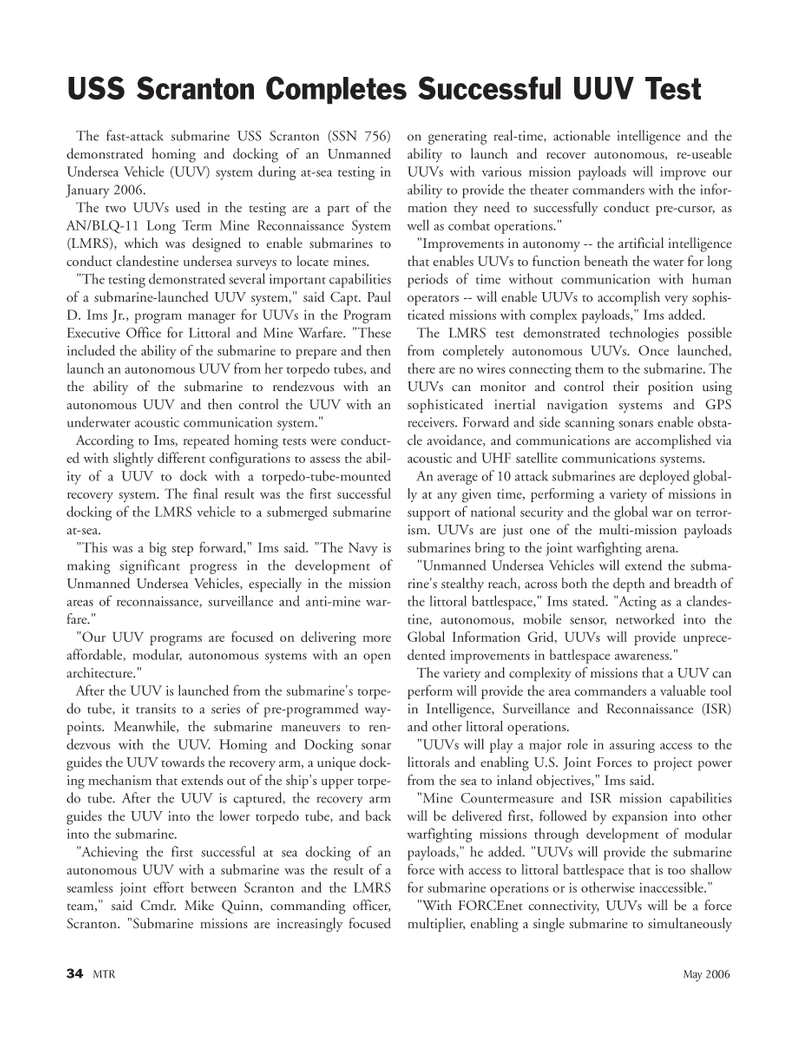
Page 34: of Marine Technology Magazine (May 2006)
The Communications Edition
Read this page in Pdf, Flash or Html5 edition of May 2006 Marine Technology Magazine
34 MTR May 2006
The fast-attack submarine USS Scranton (SSN 756) demonstrated homing and docking of an Unmanned
Undersea Vehicle (UUV) system during at-sea testing in
January 2006.
The two UUVs used in the testing are a part of the
AN/BLQ-11 Long Term Mine Reconnaissance System (LMRS), which was designed to enable submarines to conduct clandestine undersea surveys to locate mines. "The testing demonstrated several important capabilities of a submarine-launched UUV system," said Capt. Paul
D. Ims Jr., program manager for UUVs in the Program
Executive Office for Littoral and Mine Warfare. "These included the ability of the submarine to prepare and then launch an autonomous UUV from her torpedo tubes, and the ability of the submarine to rendezvous with an autonomous UUV and then control the UUV with an underwater acoustic communication system."
According to Ims, repeated homing tests were conduct- ed with slightly different configurations to assess the abil- ity of a UUV to dock with a torpedo-tube-mounted recovery system. The final result was the first successful docking of the LMRS vehicle to a submerged submarine at-sea. "This was a big step forward," Ims said. "The Navy is making significant progress in the development of
Unmanned Undersea Vehicles, especially in the mission areas of reconnaissance, surveillance and anti-mine war- fare." "Our UUV programs are focused on delivering more affordable, modular, autonomous systems with an open architecture."
After the UUV is launched from the submarine's torpe- do tube, it transits to a series of pre-programmed way- points. Meanwhile, the submarine maneuvers to ren- dezvous with the UUV. Homing and Docking sonar guides the UUV towards the recovery arm, a unique dock- ing mechanism that extends out of the ship's upper torpe- do tube. After the UUV is captured, the recovery arm guides the UUV into the lower torpedo tube, and back into the submarine. "Achieving the first successful at sea docking of an autonomous UUV with a submarine was the result of a seamless joint effort between Scranton and the LMRS team," said Cmdr. Mike Quinn, commanding officer,
Scranton. "Submarine missions are increasingly focused on generating real-time, actionable intelligence and the ability to launch and recover autonomous, re-useable
UUVs with various mission payloads will improve our ability to provide the theater commanders with the infor- mation they need to successfully conduct pre-cursor, as well as combat operations." "Improvements in autonomy -- the artificial intelligence that enables UUVs to function beneath the water for long periods of time without communication with human operators -- will enable UUVs to accomplish very sophis- ticated missions with complex payloads," Ims added.
The LMRS test demonstrated technologies possible from completely autonomous UUVs. Once launched, there are no wires connecting them to the submarine. The
UUVs can monitor and control their position using sophisticated inertial navigation systems and GPS receivers. Forward and side scanning sonars enable obsta- cle avoidance, and communications are accomplished via acoustic and UHF satellite communications systems.
An average of 10 attack submarines are deployed global- ly at any given time, performing a variety of missions in support of national security and the global war on terror- ism. UUVs are just one of the multi-mission payloads submarines bring to the joint warfighting arena. "Unmanned Undersea Vehicles will extend the subma- rine's stealthy reach, across both the depth and breadth of the littoral battlespace," Ims stated. "Acting as a clandes- tine, autonomous, mobile sensor, networked into the
Global Information Grid, UUVs will provide unprece- dented improvements in battlespace awareness."
The variety and complexity of missions that a UUV can perform will provide the area commanders a valuable tool in Intelligence, Surveillance and Reconnaissance (ISR) and other littoral operations. "UUVs will play a major role in assuring access to the littorals and enabling U.S. Joint Forces to project power from the sea to inland objectives," Ims said. "Mine Countermeasure and ISR mission capabilities will be delivered first, followed by expansion into other warfighting missions through development of modular payloads," he added. "UUVs will provide the submarine force with access to littoral battlespace that is too shallow for submarine operations or is otherwise inaccessible." "With FORCEnet connectivity, UUVs will be a force multiplier, enabling a single submarine to simultaneously
USS Scranton Completes Successful UUV Test
MTR#4 (33-48).qxd 5/8/2006 10:08 AM Page 34

 33
33

 35
35
